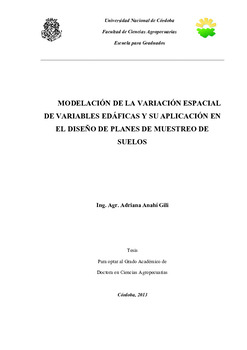| dc.contributor.advisor | Balzarini, Mónica Graciela | |
| dc.contributor.author | Gili, Adriana Anahí | |
| dc.date.accessioned | 2014-12-22T19:36:52Z | |
| dc.date.available | 2014-12-22T19:36:52Z | |
| dc.date.issued | 2013 | |
| dc.identifier.uri | http://hdl.handle.net/11086/1681 | |
| dc.description | Tesis (Doctor en Ciencias Agropecuarias)--UNC- Facultad de Ciencias Agropecuarias, 2013. | es |
| dc.description.abstract | El análisis estadístico de la variabilidad espacial de propiedades edáficas en suelos
con laboreo agrícola puede realizarse con métodos geoestadísticos clásicos, pero también
con métodos más contemporáneos como los modelos lineales mixtos (MLM) y los
métodos multivariados de análisis espacial (MULTISPATI-PCA). El objetivo de esta tesis
fue la evaluación de métodos para el estudio de la variabilidad espacial de características
de suelo en la Región Semiárida Argentina y su aplicación en el diseño de planes de
muestreo. Los datos fueron relevados considerando la escala más fina (lote) en dos
sistemas de manejo, labranza convencional (LC) y siembra directa (SD), y dos
profundidades de muestreo (0-5 cm y 5-10 cm). Se realizaron análisis de las fracciones
texturales, fósforo disponible (P), materia orgánica (MO) y nitrógeno total (N). Para la
investigación metodológica se computaron simulaciones no condicionales basada en las
estimaciones de los parámetros obtenidas a partir de datos reales. Las variables P, MO y N
mostraron variabilidad espacial bajo LC independientemente de la profundidad del
muestreo. Con la escala utilizada no fue posible describir variabilidad espacial de las
fracciones texturales. En SD también se pudo caracterizar la variabilidad espacial de las
propiedades químicas y se encontraron diferencias marcadas entre las profundidades. La
estimación de los parámetros para caracterizar la variabilidad espacial fue menos precisa y
menos eficiente con los métodos geoestadísticos clásicos que con MLM. La estimación
máximo verosímil presentó mejor desempeño que la estimación máximo verosímil
residual. Con MULTISPATI-PCA se explicó la distribución espacial en sentido
multivariado. Respecto al diseño de muestreo se generaron recomendaciones según el
interés fuese caracterizar la distribución de variables edáficas vía promedios y varianza
total o la descripción espacial de la variabilidad. En el primer caso, con un tamaño
muestral de 10 puntos se pueden obtener estimaciones precisas (menor sesgo), y con 30
puntos las estimaciones fueron también eficientes (con baja varianza). En el segundo caso,
será necesario trabajar con 100 o más puntos de muestreos. Si se utiliza un diseño
sistemático, la distancia entre los puntos debe ser próxima a la mitad del rango. En caso de
no conocer la posible estructura espacial, se pueden realizar estimaciones a través de
análisis basados en diseños anidados o bien realizar un profuso diseño aleatorio simple. | es |
| dc.description.abstract | The statistical analysis of spatial variability of
soil properties in agricultural soils
can be performed with classical geostatistical meth
ods, but also more contemporary
methods such as linear mixed models (MLM) and multi
variate methods of spatial analysis
can be applied (MULTISPATI-PCA). The objective of t
his thesis was the evaluation of
methods for the study of spatial variability, its a
pplication in soil characteristics in semiarid
region of Argentina and the design of soil sampling
plans. Data were collected considering
the smallest scale (field) under two soil managemen
t systems, conventional tillage (LC)
and no tillage (SD) and two depths (0-5 cm and 5-10
cm). Textural fractions, phosphorus
available (P), organic matter (MO) and total nitrog
en (N) analysis were performed. For
methodological research spatial data were computed
by non-conditional simulation, using
as parameters the estimates obtained from real data
. The variables P, MO and N showed
spatially variability under LC regardless of the de
pth of sampling. At the scale used it was
not possible to describe spatial variability of tex
tural fractions. In SD the spatial variability
of the chemical variables could also be described a
nd marked differences between depths
were found. The estimation of the parameters charac
terizing the spatial variability obtained
through traditional geostatistical methods were les
s accurate and efficient than those
obtained by MLM. The maximum likelihood estimation
revealed better performance than
the residual maximum likelihood estimation. With th
e use of MULTISPATI-PCA the
spatial distribution in multivariate sense could be
explained. Regarding the sampling
design, recommendations were generated according if
the main interest was to characterize
the soil variables via average and total variance o
r to characterize the spatial variability. In
the first case, with a sample size of 10 points acc
urate estimations can be obtained, and
with a sample size of 30 points the estimations are
also efficient. In the second case, it will
be necessary to work with sample sizes of 100 or mo
re sampling points. For a systematic
design the distance between the sampling points sho
uld be close to range. In case of not
having prior knowledge of the spatial structure, it
is possible to make estimations of the
range through analysis based on nested designs or m
ake a profuse simple random design. | en |
| dc.format.extent | 191 h. : ilustración color | |
| dc.language.iso | spa | es |
| dc.rights | Atribución-NoComercial-SinDerivadas 2.5 Argentina | * |
| dc.rights.uri | http://creativecommons.org/licenses/by-nc-nd/2.5/ar/ | * |
| dc.subject | Suelo | es |
| dc.subject | Muestreo | es |
| dc.subject | Modelos lineales | es |
| dc.subject | Labranza | es |
| dc.subject | Siembra directa | es |
| dc.subject | Estadística | es |
| dc.subject | Métodos estadísticos | es |
| dc.subject | Zona semiárida | es |
| dc.subject | Argentina | es |
| dc.title | Modelación de la variación espacial de variables edáficas y su aplicación en el diseño de planes de muestreo de suelos | es |
| dc.type | doctoralThesis | es |





